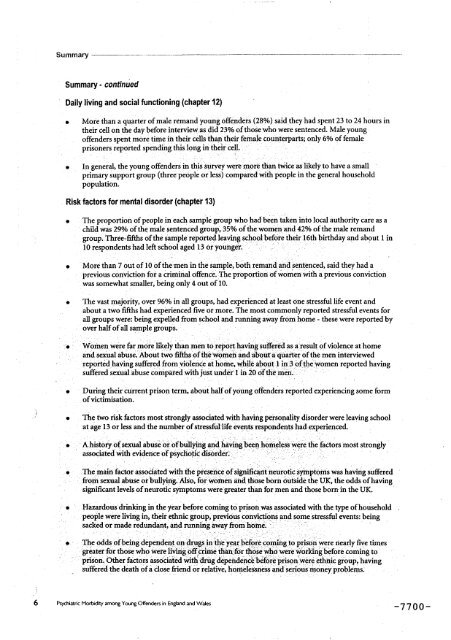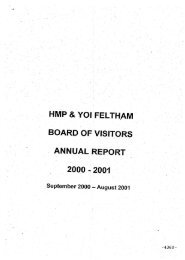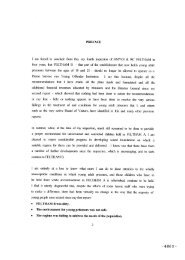Neurotic disorders
Neurotic disorders
Neurotic disorders
Create successful ePaper yourself
Turn your PDF publications into a flip-book with our unique Google optimized e-Paper software.
Summary<br />
Summary-<br />
continued<br />
Daily living and social functioning (chapter 12)<br />
• More than a quarter of male remand young offenders (28%) said they had spent 23 to 24 hours in<br />
their Cellon the day before interviewas did 23% of those who were sentenced. Male young<br />
offenders spent more time in their cells than their female counterparts; only 6% of female<br />
prisoners reported spending this long in.their cell.<br />
• In general, the young offenders in this Survey weremore than twice as likely to have a small<br />
primary support group (three people or less) compared with people in the general household<br />
population.<br />
Risk factors for mental disorder (chapter 13)<br />
• The proportion of people in each sample group who. had been taken into local authority care as a<br />
child was 29% of the male sentenced group, 35% of the women and 42% of the male remand<br />
group. Three-fifths of the sample reportedleaving school before their 16th birthday and about 1 in<br />
10.respondents had left school aged 13 0r younger. " • .-<br />
• More than 7 out of 10 ofthemen in the sample, both remand and Sentenced, said they had a<br />
previous conviction for a criminal offence. The proportion of women with a previous conviction<br />
was somewhat smaller, being only 4 out of 10.<br />
• The vast majority, over 96% in all groups, had experienced at least one stressful life event and<br />
about a two fifths had experienced five or more. The most commonly reported stressful events for<br />
all groups were: being expelled from school and running away from home - these were reported by<br />
over half of all sample groups.<br />
• Women were far more likely tha n men to repo_ having Suffered as a:result of violence at home<br />
and sexual abuse. :About two fifths of the Wome/i and about a:quarter of the men interviewed<br />
reported having suffered from violence at home, whileabout I in3 0fthe women reported having<br />
suffered sexual abuse compared with just under'l in 20 of the m_n. _<br />
• During their current prison term, about half of young offenders reported experiencing some form<br />
of victimisation.<br />
• The two risk factors most Strongly associated with having pe/Sonality disorder were leaving school<br />
at age13 or less and the number of stressful life events respondents had experienced.<br />
... _. . . • _<br />
• A historyof sexual abuseOf, of bullying and having been homelesswere the factors most strongly<br />
associated With evidence0fpsychotic disorder. " " "_ _ • .... .: i :<br />
• The main factor associated with the pre_nce of significant neuroti c symptoms was having Suffered<br />
from sexual abuse or bullying. Also, for Wbrnen and those born Outside the UK, the odds of having<br />
significant levels of neurotic symptoms weregreater than for men and those born. in the UK.<br />
• Hazardous:drinking in the year before coming t0 prison was associated with the type of household<br />
people were living in, their ethnic group, previous convictions and some stressful events: being<br />
sacked or made redundant, and running away from home; -_<br />
• The odds ofbeing dependent 0n drugs in:the year before coming to prison were nearly five times<br />
greater for thos e who were ti_g.0ff_Jm6 t_n f6r _e whc_were _ork_ngbe-fote coming to<br />
p/:son. Other factors associated With dn_g dependenc_be_dreprison_were ethnic group, having<br />
suffered the death of a Close friend 0rrelatiye, homeie_snessand SeriOusm0neg problems:<br />
6 Psychiatric Morbidity among YoungOffenders inEnglandandWales --7 7 0 0 -

















